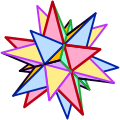File:Stellation 3 of dodecahedron and convex hull.svg

Original file (SVG file, nominally 780 × 780 pixels, file size: 4 KB)
Captions
Captions
Summary
edit| DescriptionStellation 3 of dodecahedron and convex hull.svg |
English: “Dodecahedron” means “polyhedron of twelve faces”. The faces of a regular dodecahedron are twelve regular polygons of same size, which have five edges: convex pentagons or pentagonal stars. Two regular dodecahedra have convex faces: a convex polyhedron also called “Platonic dodecahedron”, as well as a “great dodecahedron”, which is not convex. A “great stellated dodecahedron” is a nonconvex regular dodecahedron of twenty vertices, the faces of which are pentagonal stars. Its vertices are those of its convex hull: a Platonic dodecahedron. On any image of the series, such a dodecahedron hides one of its vertices at the drawing center. The transparent thick lines on certain images reveal the edges of the convex hull. When the image shows a Platonic dodecahedron inside a great stellated dodecahedron, a same colour at the surface of two polyhedra indicates two faces in a same plane. In this case, any edge of a face of a given colour is parallel to one of the five edges of the other face of the same colour.
Français : “Dodécaèdre” signifie “polyèdre de douze faces”. Les faces d’un dodécaèdre régulier sont douze polygones réguliers de la même taille, qui ont cinq côtés : des pentagones convexes ou étoilés. Ont des faces convexes un dodécaèdre régulier convexe, aussi appelé “dodécaèdre de Platon”, ainsi qu’un “grand dodécaèdre”, qui n’est pas convexe. Un “grand dodécaèdre étoilé” est un dodécaèdre régulier non convexe de vingt sommets, dont les faces sont des pentagones étoilés. Ses sommets sont ceux de son enveloppe convexe : un dodécaèdre de Platon. Dans n’importe quelle image de la série, un tel dodécaèdre cache l’un de ses vingt sommets au centre du dessin. Les traits épais transparents de certaines images mettent en évidence les arêtes de l’enveloppe convexe. Quand l’image montre un dodécaèdre de Platon à l’intérieur d’un grand dodécaèdre étoilé, une même couleur à la surface des deux polyèdres indique deux faces dans un même plan. Dans ce cas, n’importe quel côté d’une face d’une couleur donnée est parallèle à l’un des cinq côtés de l’autre face de cette couleur-là.
|
| Date | |
| Source | Own work |
| Author | Arthur Baelde |
| Other versions |
|
| SVG development InfoField | This /Baelde was created with a text editor. |
Licensing
edit- You are free:
- to share – to copy, distribute and transmit the work
- to remix – to adapt the work
- Under the following conditions:
- attribution – You must give appropriate credit, provide a link to the license, and indicate if changes were made. You may do so in any reasonable manner, but not in any way that suggests the licensor endorses you or your use.
- share alike – If you remix, transform, or build upon the material, you must distribute your contributions under the same or compatible license as the original.
File history
Click on a date/time to view the file as it appeared at that time.
| Date/Time | Thumbnail | Dimensions | User | Comment | |
|---|---|---|---|---|---|
| current | 09:07, 15 April 2018 |  | 780 × 780 (4 KB) | Arthur Baelde (talk | contribs) | User created page with UploadWizard |
You cannot overwrite this file.
File usage on Commons
The following 12 pages use this file:
- Commons:Categories for discussion/2018
- Commons:Categories for discussion/2018/09
- Commons:Categories for discussion/2018/09/Category:Kepler-Poinsot solids; Baelde style; 3-fold
- File:A great stellated dodecahedron.svg
- File:Convex hull of great stellated dodecahedron.svg
- File:Great stellated dodecahedron.svg
- File:Great stellated dodecahedron again.svg
- File:Great stellated dodecahedron and convex hull.svg
- File:One more great stellated dodecahedron.svg
- File:Stellation 3 of dodecahedron.svg
- File:Third stellation of a dodecahedron.svg
- File:Third stellation of dodecahedron and convex hull.svg
Metadata
This file contains additional information such as Exif metadata which may have been added by the digital camera, scanner, or software program used to create or digitize it. If the file has been modified from its original state, some details such as the timestamp may not fully reflect those of the original file. The timestamp is only as accurate as the clock in the camera, and it may be completely wrong.
| Width | 780 |
|---|---|
| Height | 780 |








